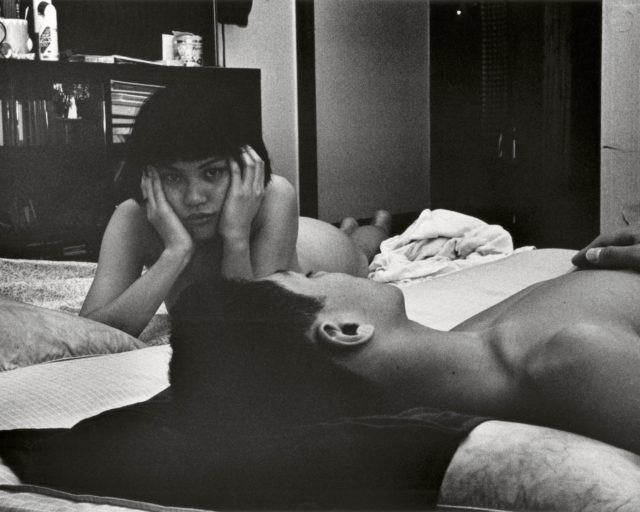In Kashmir, Hope Blooms
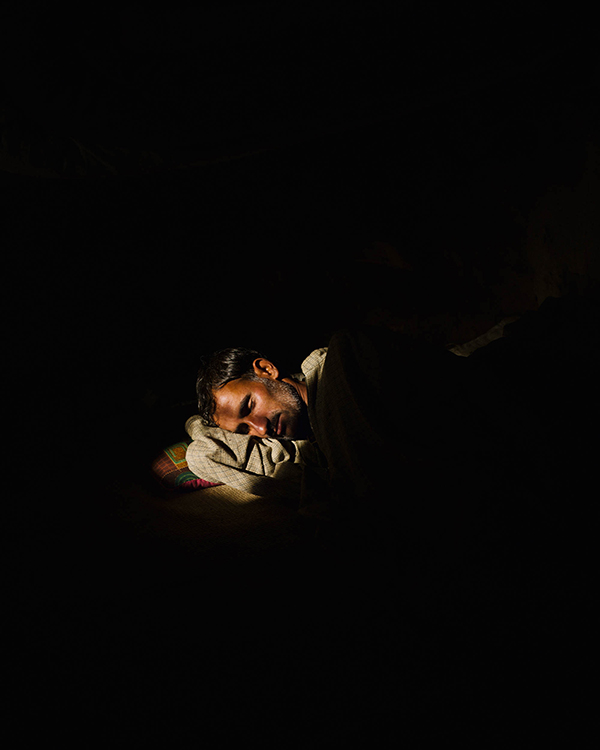
Bharat Sikka, Untitled, 2016, from the book Where the flowers still grow
© the artist and courtesy Loose Joints
Bharat Sikka first visited Kashmir as an adult, in 2014, at the age of forty. Raised in India, Sikka is best known for photographs that explore the nation’s recent economic and cultural shifts. Over several trips to Kashmir, Sikka has created a body of work that transports the viewer to its mountains and valleys. Oscillating between intimate portraits of men and sweeping landscapes, Sikka presents a poetic view of this disputed region.
I recently spoke with Sikka, who now lives between India and Europe, and he described his new photobook, Where the flowers still grow (2017), as “an emotional response” to Kashmir. The book acts as a recollection of emotions and experiences in Kashmir, allowing readers travel with Sikka on his journey. He focuses in on vivid details: the pink and purple blooms of spring, fresh footprints in the snow, a makeshift wooden fence. Amidst these idyllic scenes are the men of Kashmir, gathering wood, atop their horses, or reclining in a field of yellow flowers. The homes and interiors that appear in these pages are often deserted, as if the men belong to the snowy mountains, not in the cabins patched with sheets of tin. To Sikka, the men are just as much a part of the landscape as the pine trees.
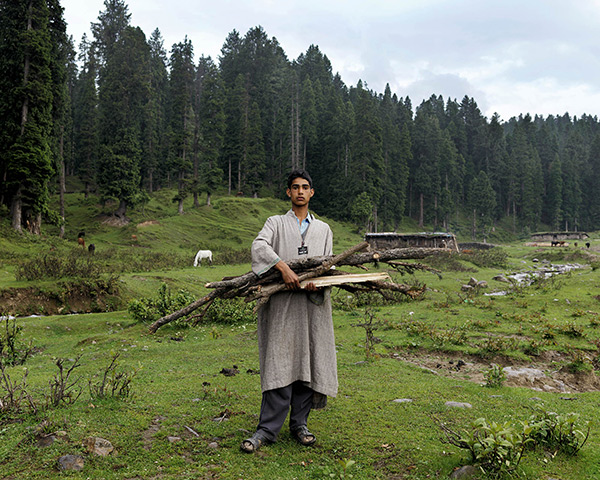
Bharat Sikka, Untitled, 2015, from the book Where the flowers still grow
© the artist and courtesy Loose Joints
Emma Kennedy: What is the meaning behind the title of this series?
Bharat Sikka: Where the flowers still grow—a glimpse of hope in a disturbed area. Kashmir is known as one of the world’s most beautiful mountain valleys, but it has gone through so much turbulence and political conflict that nobody thinks about it in that way anymore.

Bharat Sikka, Untitled, 2016, from the book Where the flowers still grow
© the artist and courtesy Loose Joints
Kennedy: There are no children or women in the images. Why do you focus only on men, often in isolation in the landscape?
Sikka: Almost all my projects—from the beginning, starting with Indian Men (1999–2003)—are about men. I am naturally drawn towards photographing men, especially as subjects. I feel I have more to say about them, although they do make me uncomfortable. In Kashmir, I came across more men than women. It became about the relationship of a man with his space, and I wanted to make the narrative specifically about these men living in their land. In the series, I felt that men played a dominant role, just by their visual presence, especially outdoors, and their constant physical engagement in the political conflict. I had a stronger emotional response to the men. I was perhaps more intimidated by them.
On my first trip to Kashmir, I just photographed men as I found them in the landscape. The style was instinctive based on what I’d shot before: just positioning the person in their environment, and telling a narrative about them through their space—that’s very me. The people are very isolated there, and there are many reasons—some political—why I decided to isolate them in the landscape, which knows nothing of national borders and political rivalries.

Bharat Sikka, Untitled, 2014–16, from the book Where the flowers still grow
© the artist and courtesy Loose Joints
Kennedy: This series came into being, in part, because of your discovery of Mirza Waheed’s novel The Collaborator (2011). How did the book help you conceptualize the physical and emotional landscapes of Kashmir?
Sikka: I haven’t read the book. During that first trip, my wife read it and told me the story, which is about a young boy and his struggles with his own sense of self in this turbulent region. I didn’t want to interpret the story, but by being in that space and moment, it made a lot of sense. And then I came across this one boy carrying sticks who reminded me of the book’s protagonist, and it started from there. The whole story is about this young boy, another reason why the project has just been about men. The book helped me gain clarity about how to proceed.
Kennedy: The image of the man in yellow with his back to the camera reminds me of the iconic nineteenth-century painting Wanderer above the Sea of Fog by Caspar David Friedrich. Could you talk a little about your influences for this series and your practice in general?
Sikka: I love this reference. I do look at paintings, and was influenced by Edward Hopper quite a lot in my earlier projects. For Where the flowers still grow, a lot of the influence came from my earlier projects. I also wanted to reinvent, and at the same time use my own style, and bring a narrative to the whole project.
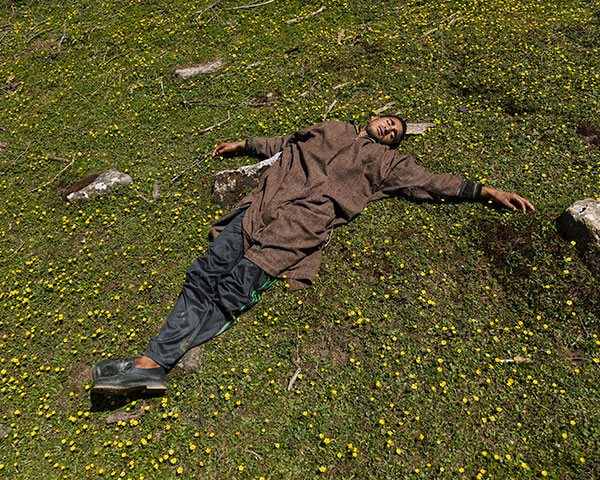
Bharat Sikka, Untitled, 2014–16, from the book Where the flowers still grow
© the artist and courtesy Loose Joints
Kennedy: Another of your series, Space in Between (2003–7), also explores the Indian landscape. How do you think about landscape and geography?
Sikka: I am really drawn towards spaces. Even when I take portraits, I place the subjects in their environment, and I often wonder if the picture is more about the space and if the person is just a prop in it. In Space in Between, I was really interested in how India was evolving geographically. In that series and in Matter (2006–ongoing), I explore how India is losing its culture as we become more globalized and homogenized. I think India is confused and now looks dull and grey, especially in the urban areas. It’s not the exotic country that it was years ago. Industrial revolution never took place in India, and nothing was ever planned, or made in a logical way, and now all of this is decaying and cities are overpopulated and polluted.
Kashmir is an extremely beautiful place and has been photographed and documented in many different ways, mostly as pin up calendars with incredible landscapes, sunsets and flowers, or in a very documentary style.
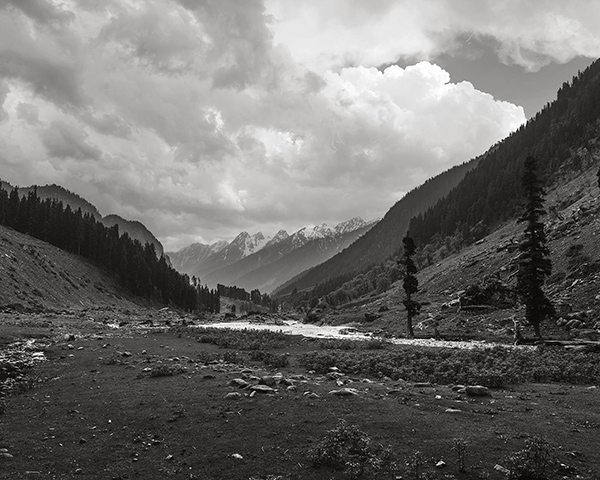
Bharat Sikka, Untitled, 2015, from the book Where the flowers still grow
© the artist and courtesy Loose Joints
Kennedy: The landscapes you capture have a specificity to them, but they also refer to the larger history of landscape photography. For example, your images of valleys and mountain ranges recall those of Carleton Watkins and Ansel Adams, who photographed the grandeur of the American West. If I hadn’t known it was Kashmir, I probably wouldn’t have been able to identify the geographic location. How important is it that the viewer knows where the photographs were taken?
Sikka: I come from a strong Indian background. I spent my first twenty-four years in India, and hadn’t really discovered the world of fine art photography until I went to school at Parsons. I was exposed to all these photographers, even the contemporary ones like Joel Sternfeld and Stephen Shore. Then, when I reflected back on India, I really wanted to show a totally different side of it and how it could be seen in a completely new way. That is also an important part of my work, to move away from my Indian contemporaries and how they’ve explored India. I wanted to move away from all the stereotypical images that are associated with India, especially the ethnic ones.
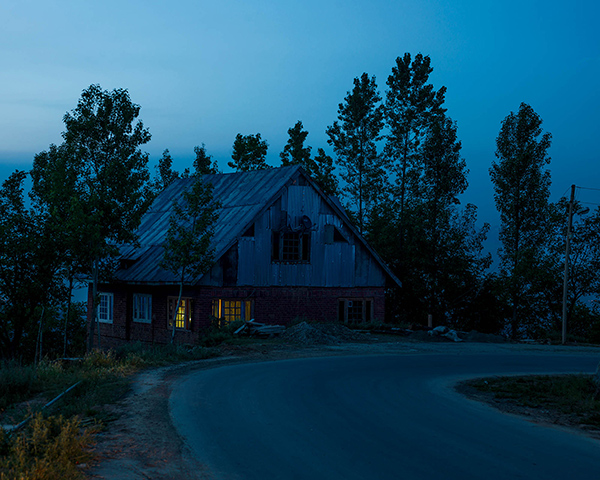
Bharat Sikka, Untitled, 2016, from the book Where the flowers still grow
© the artist and courtesy Loose Joints
Kennedy: The cover image for Where the flowers still grow is almost completely black. It is such a dark image compared to the others in the series and its presence (or perhaps its “absence” of photographic information) really surprised me. Could you talk a little about this image and how it became the cover?
Sikka: I grew to really like the cover. First, because it was ambiguous and unexpected. Second, the white dot is actually a distant star in a dark sky, and reminds me of a light, like a glimmer of hope, which is similar to the idea behind the title of the book. Third, it reminds me of a conversation I had with my driver Shabir about meteorites—how its pieces fall from the sky, and how people in the past have become rich by finding them, and how he too hoped to find one someday.
Where the flowers still grow was published by Loose Joints in 2017.












